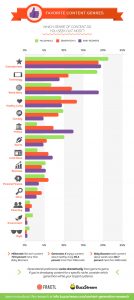21 Aug Content for Millennials, Gen X & Baby Boomers
Of course, whatever the channel, the most important aspect of a creative strategy or the creative brief, is the consumer. Who they are, what motivates and influences them and how they behave.
We’ve noticed recently that brands and advertisers are most keen to create content that Uber-loving, Tinder-swiping Millennials will consume.
This despite the fact that Millennials, Generation X and Baby Boomers share a lot of behaviours. Both Gen X and Millennials are strong users of VPNs; second-screening is widespread across all generations, and all three generations are increasing the amount of product and experience reviews they create on social and retail sites.
The infographic below, from Fractl and buzzstream and featured on Moz, shows that all three generations engage with entertainment content, the most.
(Click on image to enlarge)
Of course, there are differences in behaviour. Baby Boomers engage with world news the most, Gen Xers are most engaged with personal finance, parenting & healthy living. Millennials engage with comedy the most.
And here’s something interesting: Baby Boomers, the highest consumer spenders, engage with content most:
(Click on image to enlarge)
There are plenty more inter-generational insights, including when content is consumed by different generations, device preference and most/least shared content, here.
Another inter-generational similarity, highlighted by comScore is that mobile social media engagement is growing at least 25% YOY across every age group. And older users prefer tablets to smartphones:
(Click on image to enlarge)
Of course, differences occur in the reasons why the different generations engage. Millennials run their lives on their smartphones, whereas GenX and Baby Boomers are digital immigrants, and are not as reliant on the internet.
A study just published in Womenswear Daily is a reality check on multi-generational consumer behaviour. In the US, Gen X, 25% of the population, has 30% of spending share at retail. Millennials comprise 33% of the population, yet have only 12% of spending share. Baby Boomers, 30% of the population have 43% of share and the Silent Generation, which is 12% of the US population, has 15% of spending share.
Although the report highlights behavioural differences, e.g. about half of the Millennials surveyed use their mobile devices for shopping research, while only 17% of Boomers do the same, it highlights behavioural similarities: Baby Boomers and Millennials are both more likely to buy online if they have a discount coupon or code and both generations are greatly influenced by in-store promotions.
Finally, Gen Z.
What if we move from thinking about generations in terms of different values, experiences and behaviour, and see consumers united by the simplicity and affordability of technology?
Koulopoulus and Keldsen published Gen Z Effect last year. They explain that although Gen Z defines the hyper-connected, life-hacking people born between 1995-2015, technology is changing everyone’s behaviours and beliefs so rapidly that the timespan to be considered one generation or the next is shortening and Gen Z will not just be a birth definition, it will be a generation choice. Those who embody the behaviours and beliefs of Gen Z are Gen Z, whenever they were born.
Not a concept suited to a nutshell – and the book is a data-rich serious read, but this video explains all in 6 minutes (we like the reverse mentoring practice where younger employees “percolate up” experience and knowledge to their older “protéges”, at companies like Cisco.)






Lloyd Keech
Posted at 16:23h, 23 FebruaryDear murphycobb.com webmaster, Your posts are always a great source of information.